

The $2.5 trillion reason we can’t rely on batteries to clean up the grid. A pair of 500-foot smokestacks rise from a natural-gas power plant on the harbor of Moss Landing, California, casting an industrial pall over the pretty seaside town.

If state regulators sign off, however, it could be the site of the world’s largest lithium-ion battery project by late 2020, helping to balance fluctuating wind and solar energy on the California grid. The 300-megawatt facility is one of four giant lithium-ion storage projects that Pacific Gas and Electric, California’s largest utility, asked the California Public Utilities Commission to approve in late June.
Collectively, they would add enough storage capacity to the grid to supply about 2,700 homes for a month (or to store about .0009 percent of the electricity the state uses each year). But there’s a problem with this rosy scenario. These batteries are far too expensive and don’t last nearly long enough, limiting the role they can play on the grid, experts say. Small doses And that ends up being astronomically expensive. Ditch the Batteries: Off-Grid Compressed Air Energy Storage - Resilience. These diamond batteries made from nuclear waste can last 5,000 years.
Scientists from the University of Bristol’s Cabot Institute have discovered an innovative way to recycle radioactive waste. In December last year, they designed a diamond that can generate electricity and last for over 5,000 years. A report by the World Economic Forum read,The radioactive uranium in nuclear power plants split during the process of nuclear fussion. When split, these atoms generate heat which eventually vaporises water into steam which can be used as electricity to generate turbines.
Rail Energy Storage Harnesses the Power of Gravity All the Livelong Day - Seeker. “We use no water, burn no fossil fuel, produce no emissions, and use no hazardous or environmentally troubling materials like lithium,” ARES CEO James Kelly told Seeker.
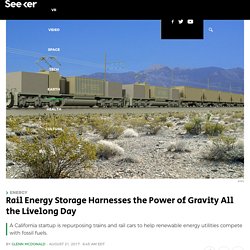
“We are excited to be a green storage solution that can enable higher penetration of intermittent renewable resources — like wind and solar — in the US and around the world.” Pushing rocks up a hill might seem like a curiously low-tech approach to energy storage, but Kelly said that this very simplicity is what gives rail energy storage an edge. SOLAR ENERGY STORAGE. Virtual power plants take green energy closer to the mass market:The Asahi Shimbun. The future looks bright for solar power with power companies’ plans to establish technology using the Internet to connect photovoltaic power facilities with batteries in homes and businesses to control their power supplies.
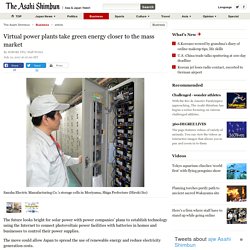
The move could allow Japan to spread the use of renewable energy and reduce electricity generation costs. The type of system being developed is known as the virtual power plant (VPP), as many power equipment and batteries linked with each other under the system work as if they were a huge single power plant. Backed by the government, power distributors and other firms, experiments are proceeding across the country to commercialize the futuristic technology.
Situated on the eastern coast of Lake Biwako, batteries installed in a factory of Sansha Electric Manufacturing Co. --an Osaka-based leading power supply device maker--have a total capacity of 200 kilowatts. An additional test is scheduled for this autumn. Tokyo Electric Power Co. Despite the hype, batteries aren’t the cheapest way to store. Storage is the word of the moment in the energy industry.

Since Tesla unveiled its Powerwall, politicians, commentators and industry have hyped storage – and particularly batteries – as the solution for getting more renewable energy into electricity grids and reducing our reliance on fossil fuels. MIT researchers see a 'window of opportunity' for non-battery storage. A report from the Massachusetts Institute of Technology on the value of energy storage finds that combining certain storage technologies with wind and solar power projects can be economic at current prices in some locations.

“There is a window of opportunity right now with storage costs and wind and solar costs where they are,” says Jessika Trancik, one of the authors of the report and the Atlantic Richfield career development assistant professor of energy studies at MIT. The study was published in Nature Climate Change and co-authored by graduate students William Braff and Joshua Mueller. The premise of the study is that wind and solar penetration is currently so small that “they do not measurably contribute to climate change mitigation at current installations levels.” Storage location: Influence limited Solar and wind power projects are not going to make greater inroads unless individual investors have a reason to invest in them, Trancik said. Plug-and-Play Grid Batteries Thanks to 1Energy’s Software.
Why do batteries for the grid cost so much more, on a per-kilowatt-hour basis, than batteries for laptops, or even for electric vehicles?
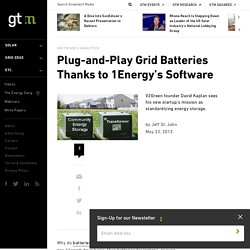
It’s not the cost of the battery technologies themselves, or even necessarily what grid customers are demanding from them. Instead, it’s that today’s grid-scale battery projects are almost all designed, built and operated as standalone projects, with mostly proprietary and sometimes single-source technologies. If automakers and computer companies tried to build products that way, they’d go out of business. What’s more, the mass market for reliable, standardized, battery-powered laptops would have never developed (the jury is still out on the mass market for EVs). David Kaplan, CEO of Seattle-based startup 1Energy, believes that software can unlock the same kind of scale and interoperability opportunities for grid-scale batteries -- at least, in terms that battery makers and their utility customers can relate to.
From V2G to MESA. 1Energy’s Platform to Rule Fleets of Batteries—and Beyond. Seattle-based startup 1Energy has been a small but spirited contender in the emerging energy storage management software field, with a decided emphasis on an open-standards-based approach to linking batteries and other grid-connected assets at scale.
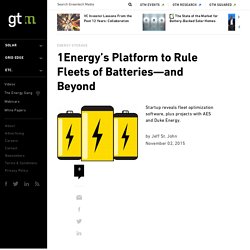
For the past few years, it has deployed its software in the form of an intelligent controller, integrating with individual battery-inverter systems in a showcase set of Pacific Northwest utility pilot projects, while promising a fleet management platform to tie them all together. Last month's launch of 1Energy's Distributed Energy Resource Optimizer, or DERO, platform marks the delivery on that promise, with some extras to boot. Energy storage. Whether we turn on the coffee maker in the afternoon or switch on the light in the bathroom in the middle of the night – in a modern world, electricity is available at any time.
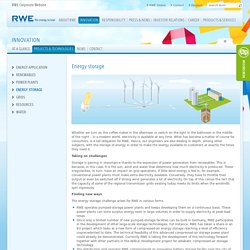
What has become a matter of course for consumers, is a tall obligation for RWE. Hence, our engineers are also dealing in depth, among other subjects, with the storage of energy in order to make the energy available to customers at exactly the times they need it. Taking on challenges Storage is gaining in importance thanks to the expansion of power generation from renewables. This is because, in this case, it is the sun, wind and water that determine how much electricity is produced.
Finding new ways The energy storage challenge arises for RWE in various forms. A game-changing battery for renewable energy. A solar field in Israel’s Arava desert.
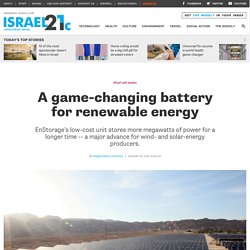
Everybody agrees that producing energy from wind, sun and other renewable resources makes good sense, but it won’t be widely adopted unless it makes good “cents,” too. One of the cost hurdles to be overcome is storing the energy in a way that maintains the balance between the peaks and lows of electricity demand and generation. That’s where Israeli startup EnStorage is making news. Its uniquely low-cost flow battery system is now being deployed at sites in France and the United States.
Solar plus storage. Energy storage business. Renewable Energy. Even Without Subsidies, Energy Storage Is Starting to Rival Conventional Resources. The economics of storage aren't easy to model.

The technology can be used for so many applications -- frequency regulation, equipment upgrade deferral, backup power, renewable energy integration, or peaking power -- that it can be hard to compare storage to conventional generation. The technologies themselves are just as diverse. But the analysts at the financial advisory firm Lazard just did it. And their work yielded some promising results. This week, Lazard released its first-ever analysis of the levelized cost of storage. There's a lot of debate about whether megawatt-hour costs are the most helpful way to measure competitiveness, since they leave out dispatchability characteristics and specific use cases for technologies. When calculating megawatt-hour costs, storage doesn't rival renewable generation in its competitiveness with conventional alternatives. The Economics of Battery Energy Storage. The Future of Energy Storage Is Behind the Meter. Today, energy storage is often described as new, emerging or risky.
But tomorrow, one word will suffice: mainstream. In California, we have a near perfect storm of market signals moving the entire energy storage industry forward. On the hardware side, OEMs (battery and inverter manufacturers) have significantly reduced costs, while forward-thinking policymakers and financiers are creating favorable regulatory and market conditions. 49. Energy Storage, the Holy Grail of Renewable Energy. Grid Energy Storage: Beyond Batteries. Octillion Power Systems. Nomadic Power. Warren Buffett: Solar and Wind Could ‘Erode the Economics of the Incumbent Utility’ Billionaire investor Warren Buffett says that renewable energy and efficiency are pushing utilities beyond a "sloppy" operational model and into a more competitive environment. In his annual letter to Berkshire Hathaway shareholders, Buffett outlined the risks posed by distributed generation to traditional power companies. Berkshire Hathaway, a multinational holding company worth nearly $200 billion, owns 10 energy companies, including three large electric utilities serving territories across 11 Midwestern and Western U.S. states.
SunEdison Buys Solar Grid Storage for Battery-Backed PV and Wind Power. Last month, we predicted that one of the country’s big vertically integrated solar companies would make a move into the energy storage business this year by acquiring a U.S. Prosumer Microgrid Solutions. Solar+Storage 101: An Introductory Guide to Resilient Solar Power Systems - Clean Energy Group. How Microgrids Work. This week we’re celebrating the launch of a new series on Energy.gov: How Energy Works. Join us today on Twitter at 2 p.m. ET for our How Energy Works live Q&A answering everything you want to know about microgrids.
Use #HowEnergyWorks to submit questions and follow the live discussion. What is a microgrid? A microgrid is a local energy grid with control capability, which means it can disconnect from the traditional grid and operate autonomously. How does a microgrid work? To understand how a microgrid works, you first have to understand how the grid works. The grid connects homes, businesses and other buildings to central power sources, which allow us to use appliances, heating/cooling systems and electronics. This is where a microgrid can help. A microgrid can be powered by distributed generators, batteries, and/or renewable resources like solar panels. Micromanaging the Microgrid - HowStuffWorks. One of the key advantages to the microgrid approach is that it allows local users to make smarter choices regarding their use of power, turning them from cowering subjects under an all-powerful king to empowered consumers in a flexible energy economy.
The Independence of Localized Power Grids - HowStuffWorks. 85581241. If you thought solar was going to hurt utilities, get a load of solar+storage. As I wrote in my previous post, power utilities are pushing back against rooftop solar, but by doing so they are only accelerating the development of solar+storage, which may prove to be an even bigger threat.